April itinerary in Japan Day 2 (Kochi, Ehime)
(Tuesday, April 19)
Table of contents
4. Okuuchi rice terraces (Yuzuriha rice terraces)
1. Shimanto River Cycling
I went cycling on the Shimanto River from 8 am on April 19th (Tuesday). It is a 42km long-distance cycling from Nakamura station downstream to Ekawasaki station upstream. It is exactly the same distance as the marathon course. Since it is a “luggage-free trip”, it is possible to cycle by dropping off (borrowing at Nakamura Station and returning at Ekawasaki Station). The route goes upstream of the river, but the slope is so gentle that it didn’t bother me. It took three and a half hours.
I thought there were other cyclists besides me, but I never saw them. I rented a bicycle at the Shimanto Tourism Association at Nakamura Station the day before for a fee of Yen 2,000 for 24 hours, so I was able to leave the hotel in the morning.

The Shimanto River is the longest river in Shikoku with a total length of 196 km. It is the 11th longest river in Japan. The Shimanto River is called “the last clear stream in Japan” because no large-scale dam has been built in the main stream. It is also one of the “three major clear streams in Japan” along with the Kakita River (Shizuoka Prefecture, total length 1.2km) and Nagara River (Gifu Prefecture, total length 166km). It has been selected as one of the Best Water 100’s and 100 selections of unexplored regions in Japan.
In the paddy fields along the Shimanto River, the scenery was beautiful just after the rice planting was finished.

It was a very pleasant cycling experience because the Shimanto River and the mountains in the fresh green season were so beautiful and I could always hear the song of bush warbler. I felt like I could hear the song of the lesser cuckoo, but it may be different considering that the lesser cuckoo arrive in May. Since I ate the first bonito on the day before and on the day of cycling, I was able to enjoy the world of the haiku “Meni wa Aoba, Yama hototogisu, hatsugatsuo (Green Leaves in Eyes, Lesser Cuckoo in Mountain, the Season’s First Bonito)”.
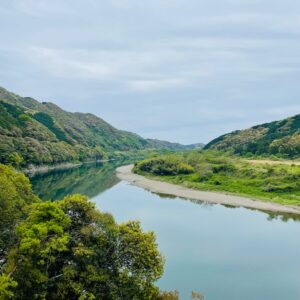
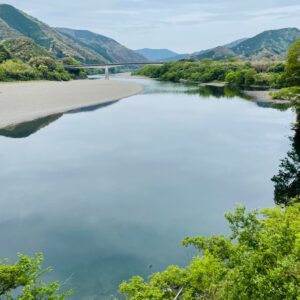
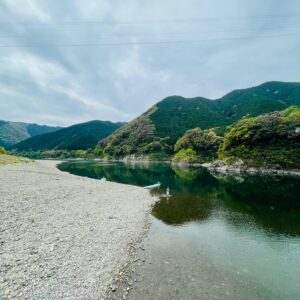
There are many “Chinka-bashi (bridge designed to be underwater during a flood)” in the Shimanto River. The total number of Chinka-bashi is 22 in the mainstream. There is no balustrade on the bridge, and it sinks during typhoons and heavy rains, preventing the entire bridge from being damaged or washed away. It can be said that the existence of the Chinka-bashi makes the Shimanto River more famous.
This time, there were 6 Chinka-bashi from Nakamura Station to Ekawasaki Station. Since I was cycling, I could stop anywhere and take pictures of all 6 Chinka-bashi. I will explain 6 Chinka-bashi from the downstream side.
The Sada Chinka-bashi bridge is the most downstream Chinka-bashi. It is the longest Chinka-bashi with a total length of 291.6m.

The Misato Chinka-bashi Bridge is the Chinka-bashi on the downstream side next to the Sada Chinka-bashi Bridge. Although the total length is only 145.8m, it was a very beautiful Chinka-bashi.


The Takase Chinka-bashi Bridge has a total length of 232.3m and is the third longest Chinka-bashi in the Shimanto River.


The Katsuma Chinka-bashi bridge has a total length of 171.4 m. It is a rare Chinka-bashi with three bridge piers. It became the shooting site of the movie “Tsuribaka Nisshi 14”.


The Kuchiyanai Chinka-bashi bridge has a total length of 241.3m. It is a Chinka-bashi with an unusual design that makes heavy use of curves.

The Iwama Chinka-bashi Bridge has a total length of 120.0 m. It is a beautiful Chinka-bashi.


A carp streamer was swimming in Tsu Ohashi in front of Ekawasaki station. The view of the carp streamer swimming over the Shimanto River was amazing.


2. Ekawasaki Station
I returned my bicycle at Ekawasaki station and headed to Matsumaru station. The trains I used are as follows.
Depart Ekawasaki Station at 12:11, Yodo Line “bound for Uwajima”, arrive at Matsumaru Station at 12:35, Fare Yen 260
The train from Ekawasaki Station to Matsumaru Station was a “Tetsudo hobby train” that was a remodeled Kiha 32 type diesel train, with the image of the first Shinkansen 0 series. The “Tetsudo hobby train” started operation in 2014. The remodeling cost was about Yen 15 million.
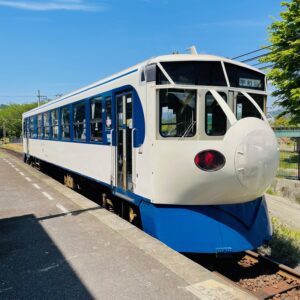
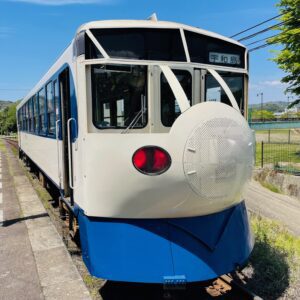
The “Tetsudo hobby train” is not only cute in appearance, but also an interesting train with many model railroads on display inside the train. There are 3 trains a day. I didn’t know the operation information at all, but I was lucky enough to get on the “Tetsudo hobby train”.
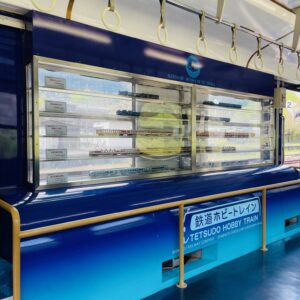
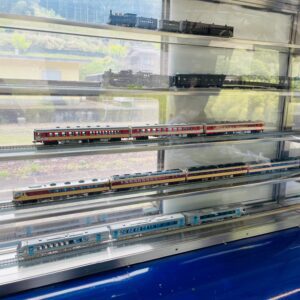
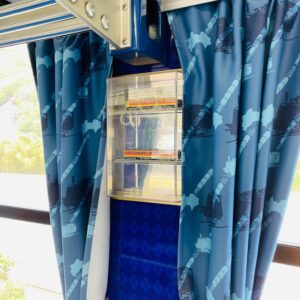
Compared to the Kiha 32 type diesel train before remodeling, the difference with the “Tetsudo hobby train” is clear.
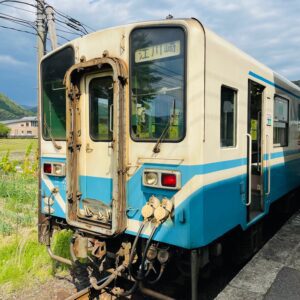
3. Matsumaru Station
Matsumaru Station has a hot spring facility called “Mori-no-kuni Poppo Onsen”. There are 18 stations nationwide with hot spring facilities. Only Matsumaru station in Shikoku. There is also a free footbath in front of the station. I was sorry that I couldn’t take a hot spring because I didn’t have time.
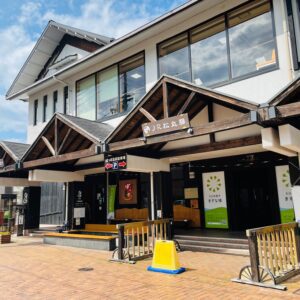
The hot water of “Mori-no-kuni Poppo Onsen” is boiled by a firewood boiler. They use firewood made from thinned wood in Matsuno Town and adopt a circulation system that consumes local resources locally.
Bathing fee: Adults Yen 520, junior high school students Yen 320, elementary school students Yen 160
If you cross the Hiromi River from Matsumaru Station, you will find “Niji no Mori Park”. There is a small aquarium called “Osakana-kan (Fishing Hall)” in “Niji no Mori Park”, and bicycles can be rented at the counter. It costs Yen 3,000 a day, but you can rent the latest GIANT E-bike (ESCAPE RX-E +). Cross bikes without an electric assist function are cheap at Yen 1,500 a day and Yen 1,000 for 4 hours. I rented an E-bike and headed to the Okuuchi rice terraces (Yuzuriha rice terraces).
In “Niji no Mori Park”, the flag for the the Boys’ Festival was flapping.
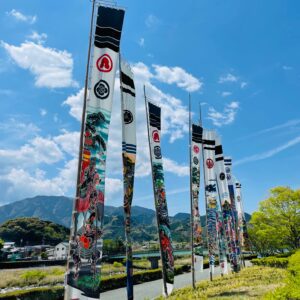
4. Okuuchi rice terraces (Yuzuriha rice terraces)
“Okuuchi Rice Terraces and Agricultural and Mountain Village Landscape” was selected as a national important cultural landscape in 2017. It is also certified as one of the “100 Best Rice Terraces in Japan” by the Ministry of Agriculture, Forestry and Fisheries. The rice terraces in the back are about 10km from Matsumaru station, and it takes about 30 minutes by bicycle. I rented an E-bike because I thought it was a steep slope, but it wasn’t really that steep, so I think I can go with a regular cross bike.
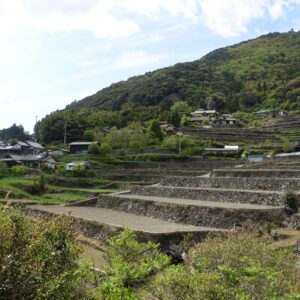
On Google Maps, it is displayed as the Yuzuriha rice terraces, not the Okuuchi rice terraces. Yuzuruha is one of the four villages of Shimogumi, Hontani, and Enokidani that make up the village in Okuuchi.
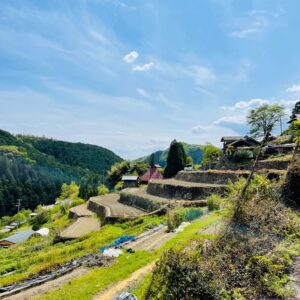
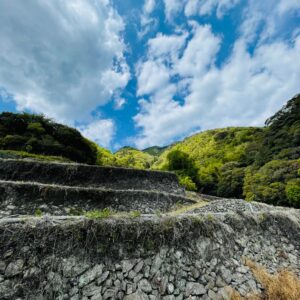
The rice terraces were a very beautiful view. It was one of the most beautiful rice terraces I have ever seen. There were almost no people in the village, because the rice planting had just finished.
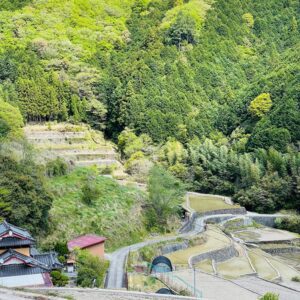
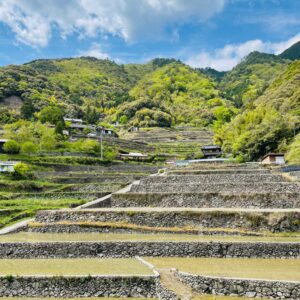
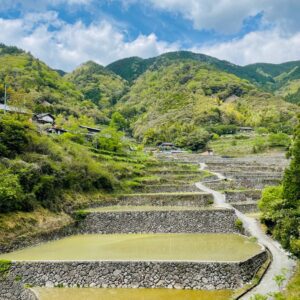
The Okuuchi Yakushido is located near the “Okuuchi Rice Terraces”. There is a “Ginkgo tree” in the precincts. It is said that when Kukai (Kobo Daishi) set up the ginkgo wand that he used when he visited Okuuchi on the ground, it sprouted and became a ginkgo of a big tree. The ginkgo tree has a root circumference of 12m and a height of 30m. It is a natural monument designated by Ehime Prefecture.
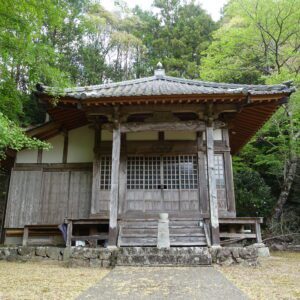
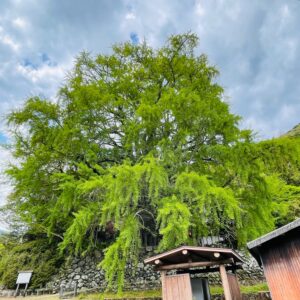
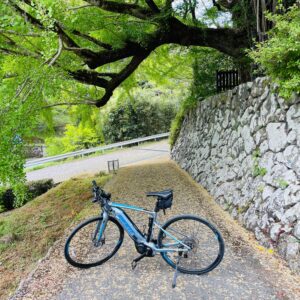
5. Uwajima Station
I returned my bicycle at “Niji no Mori Park” and headed from Matsumaru Station to Uwajima Station. The trains I used are as follows.
Depart Matsumaru Station at 15:09, Yodo Line Shiman Torokko No. 1 “bound for Uwajima”, arrive at Uwajima Station at 15:57, Fare Yen 460
We can board a trolley vehicle connected between Ekawasaki Station and Tosa-Taisho Station on the “Shiman Torokko“. There is one train operation per day. I didn’t know the schedule of the “Shiman Torokko” as well as the “Tetsudo hobby train”, but I was lucky enough to get on the train. Next time, I would like to board a trolley vehicle between Ekawasaki Station and Tosa Taisho Station.

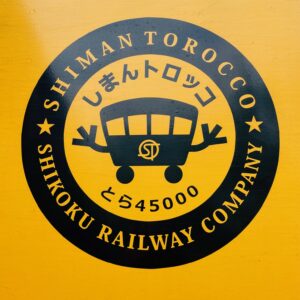
The “Shiman Torokko” was a comfortable seat. There were only two passengers other than me from Matsumaru station to Uwajima station. Let’s get on the JR Shikoku train more and support JR Shikoku.
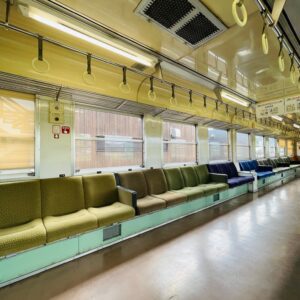
When I arrived at Uwajima station, the Anpanman train stopped, just like Kochi station.

Uwajima Station is a complete terminal station with a dead-end platform. There are few perfect terminal stations in Japan, so I like perfect terminal stations like Uwajima station.

In front of Uwajima Station, there is a replica of the first locomotive of Koppel, Germany, which was operated by the Uwajima Railway. Next to the replica, there is a monument of Takeki Owada who wrote the lyrics of “Tetsudo Shoka”, and when you press the button, “Tetsudo Shoka” is played. Takeki Owada is a Japanese scholar, poet and poet born in Uwajima in 1857. There is also a bullfighting statue near the monument. Uwajima is a bullfighting city that is rare in Japan.
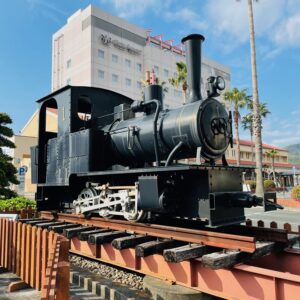

6. Uwajima Castle
After checking in at the hotel in Uwajima, I went to Uwajima Castle. Uwajima Castle is one of the existing 12 castle towers and is one of the 100 fine castles of Japan established by the Japan Castle Association. The castle tower of Uwajima Castle is a national important cultural property. The entire hill is designated as a National Historic Site. Uwajima Castle has been the residence of the Date clan in Uwajima since Hidemune Date entered the castle in 1615. Date Hidemune is the son of Masamune Date , the lord of the Sendai domain.
The 9th Uwajima feudal lord Munenari Date was called the Four Wise Lords of the Edo period along with Fukui feudal lord Shungaku Matsudaira, Tosa feudal lord Yodo Yamauchi, and Satsuma feudal lord Nariakira Shimazu.
The castle tower of Uwajima Castle is located on a hill of about 80m. It takes about 15-20 minutes to climb the stone steps from “Kori Family’s Nagaya-mon (relocated building, tangible cultural property designated by Uwajima City)” near Uwajima Station. Because the stone steps are steep, climbing to the castle tower is quite tiring.

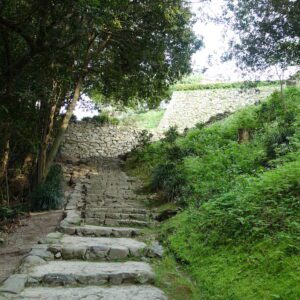
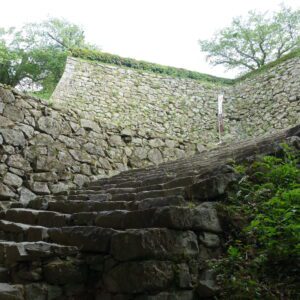
Far from Uwajima Station, on the Tensha-en Garden side, the “Agari-dachi-mon (uphill gate)” is the main gate of the samurai class. It is one of the largest existing “Yakuimon (official gate of samurai clan)” in Japan. Although the date of its foundation has not been specified, it may be the oldest in existence. It is a tangible cultural property designated by Uwajima City.

The view from the 3rd floor of the castle tower of Uwajima Castle was superb. Uwakai Sea looked very beautiful. The current castle tower is an independent tower-type three-story building that was rebuilt by the second feudal lord Munetoshi Date from 1662 to 1671. The castle tower is smaller than Himeji Castle on the 6th floors, but the view from the castle tower is one of the best among the existing 12 castle towers.
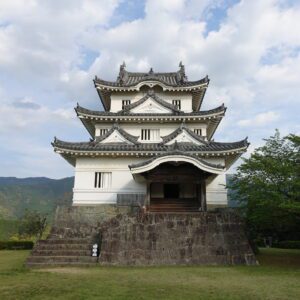
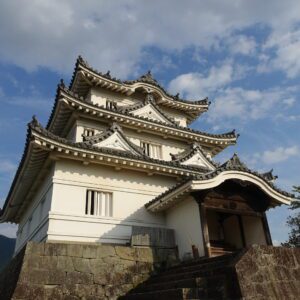
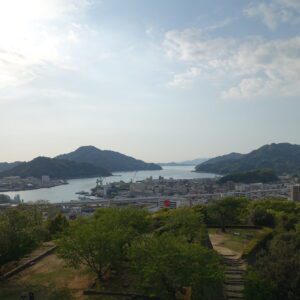
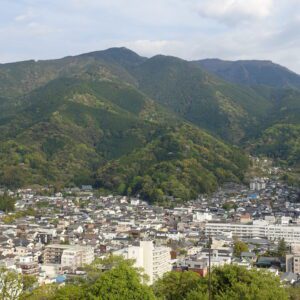
In addition to armor helmets, paintings by Hidekichi Shigemoto, a sumi-e artist from Ehime prefecture, were exhibited in the castle tower.
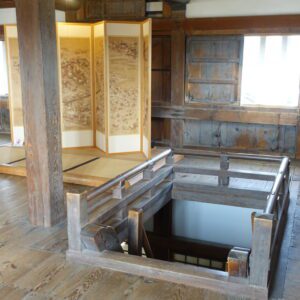
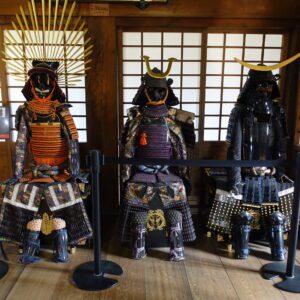
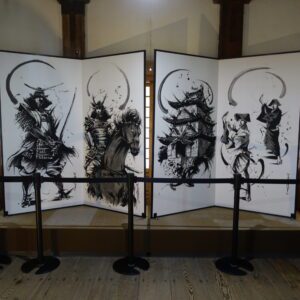
Admission to the castle tower: Yen 200 for adults, free for junior high school students and younger
Note: The departure / arrival times, fares of transportation, admission fees, meal fees, etc. listed in the text are as of the time of writing the BLOG. Please check for yourself when you go on a trip as it may change in the future.